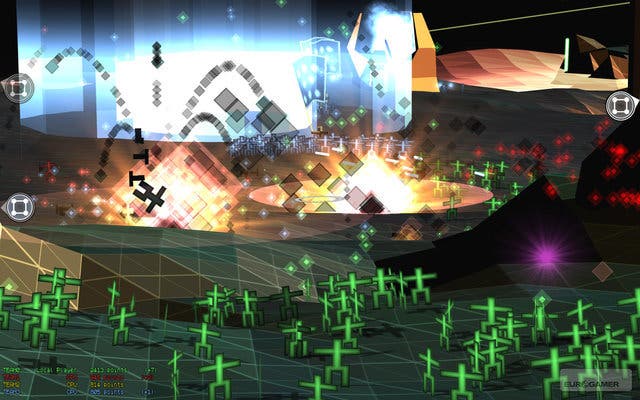Multiwinia: Survival of the Flattest
V for Vectory.
Capture the Statue is a spin on the usual flag-based retrieval games, though the sheer size and weight of the item being swiped makes it a much trickier tactical undertaking. Assault tasks one team with protecting a deadly bomb, while the other tries to penetrate the fortress to disable it. Finally there's Rocket Riot, where teams battle for control of solar panels to fuel up their space rockets. The first team to achieve blast-off wins.
If those titles sound like they'd be more at home in a first-person shooter, you'd be right. Multiwinia is an arcade game through and through (quite literally, since it will soon arrive on Xbox Live Arcade packaged with its single-player predecessor) and everything about it has been created to encourage fast, instant gratification. Time limits range from five minutes to fifteen, and even the modes which don't come with a finite countdown - such as Rocket Riot - can usually be settled in coffee break timeframes.
The maps follow the lovely lo-fi aesthetic already established in 2005, with undulating green digital hills, angular seas and an ominous grid where the sky should be. Tron is often used as a reference point, but it always reminds me most of Sentinel, Geoff Crammond's wonderfully abstract 1986 proto-stealth game. Some maps are small and compact, designed for feverish two-player skirmishes. Others are vast four-player arenas, filled with environmental details that spell out the dark times that occurred between Darwinia and this current state of war.
Whereas Darwinia wrong-footed those who expected a pure RTS experience with its need for constant micro-management of your digital adventurers, Multiwinia's more combative flavour means that pathfinding is now more reliable and directional orders can be delegated to Officers.

These are promoted Darwinians, created with a simple right click. They can then direct the constant stream of comrades from their spawn points to relevant areas - such as scoring zones - or they can form all around them into platoons, slower to move but more deadly in combat. Just these two unit types - Darwinian and Officer - form the basis of pretty much the whole game. It really is that simple.
Auxiliary abilities, many familiar from the previous game, are called into play by collecting the glowing crates which tumble slowly from the sky, Worms-style, bearing gifts from some benevolent digital deity. The more Darwinians you divert to their retrieval, the faster you'll unlock the contents. Some offer area-specific status buffs, such as additional speed or shields. Sometimes you'll get additional units, such as the manually controlled Squad which can lob grenades and shoot at specific targets with a mouse click.
Some old Darwinia foes can also be found, with ants and lumbering computer spiders available to wreak havoc on your behalf. There are also vehicles, for crossing land and water quickly, as well as gun and rocket turrets for automated defence.


